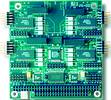
There are two features you need to consider to protect your serial communications investment: surge suppression and optical isolation.
Data communications relying on point-to-point transmissions can be disrupted by forces both natural and man-made. A transient drop or surge in power can result in a damaged system or at the very least, lost data.
Ground loops are another source of communication disruption, especially if your connection is between buildings or outdoors, where the potential for signal interference becomes more acute. While not every situation is predictable or preventable, there is a way to shield your critical data from disruption and your expensive system components from damage due to electrical surges and ground loops.
Terms
When discussing surge suppression, the terms and measurements used are often confusing. Peak voltage? Clamping voltage? What do these terms mean, and more importantly, what does it mean to your system?
Power surges, or transient voltage, is an increase in voltage above the level in a normal flow of electricity. In serial communications, this is most often caused by power lines, motors or surrounding heavy equipment discharging static. This surge can significantly damage computers or systems, causing connections to become degraded resulting in failure over time, if not immediately. A surge suppressor acts to absorb or divert this damaging energy to protect the integrated circuits.
Peak pulse current refers to the maximum current that the surge protector can withstand for a given pulse duration. (Pulse duration is the length of time needed for the peak pulse current to reach maximum value plus the length of time needed for the peak pulse current to reach 50% of its peak value. Most surge protectors are tested at an 8/20 µs waveform.)
Clamping voltage indicates what voltage will cause the protection to divert the electricity surge, therefore lower numbers usually denote better protection.
Caveat
Watch for surge protection that protects per signal. Many manufacturers offer surge protection on the data transmission signal line only. This leaves other signals vulnerable to ESD and surges. These signals might not transfer the data, but are often used in important functions such as flow control. Damage to the flow control can result in lost data transmission.
Optical isolation is necessary for situations where ground loops are likely to occur. Ground looping occurs when there is a difference in potential voltage in the ground connection path between two pieces of equipment. This acts as an antenna; one that is efficient at picking up interference currents. As a consequence of ground-loop induced voltages, the ground reference in the system is no longer a stable potential, so signals ride on the noise. The noise becomes part of the program signal.
Unlike surges, which are short bursts of high voltage, ground loops tend to be longer durations of lower voltage. Instead of diverting the electrical energy, an opto coupler effectively isolates the signals from one another by changing the electrical signal into light and then back again. Noise is filtered out and the signal alone is transmitted. This allows two different grounds to reside on either side of the electrical device without consequence. This is important since the potential difference in grounds between two or more pieces of equipment can sometimes be large enough to damage RS485 and RS232 transceivers. Again, look for optical isolation protection per individual port, not per board.
Connect Tech's products
Surge protection: EN61000-4 surge protection is standard on every signal of every port on the Blue Heat/PCI RS-485s, BlueStorm/LPs and Titan/cPCIs. The Blue Heat and BlueStorm use TransGuard transient voltage suppressors that offer a clamping voltage of 30 V, a peak current >40 A and can survive multiple strikes. Worry-free communications include line-to-frame/chassis ground - the most direct discharge path for transient energy.
Optical isolation: Connect Tech offers optical isolation on every single port, not just per board. The individual isolation rating for most optical isolation models is 3,0 kV a.c., (equivalent to 3,0 kV d.c. or 2,1 kV a.c. rms). The opto boards (Xtreme/104 Opto, Blue Heat/PCI Opto, Titan/cPCI Opto) remain protected in the field, no matter how great the potential for ground looping.

For more information contact Electronic Products Design, 012 665 9700, [email protected]
| Tel: | +27 12 493 0852 |
| Email: | [email protected] |
| www: | www.epd.co.za |
| Articles: | More information and articles about Electronic Products Design |

© Technews Publishing (Pty) Ltd | All Rights Reserved